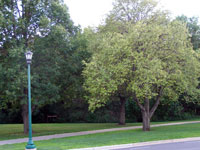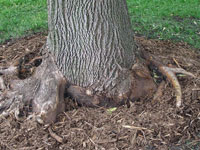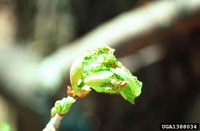Extension > Garden > Diagnose a problem > What's wrong with my plant? > Deciduous > Basswood/Linden > Thinning canopy
Basswood/Linden > Trunk/Branches > Thinning canopy
1 of 3
Stem girdling roots
- Affected trees are often stunted, exhibit poor summer color, change color and lose their leaves early in the fall
- Affected trees commonly exhibit water-stress symptoms such as marginal leaf scorch, wilting, sudden leaf fall
- Affected trees commonly exhibit excessive and abnormal winter damage including true frost cracks and dieback
- A root circling or running against one or more sides of the trunk of the tree may be seen at the soil line
- The trunk may become sunken in or compressed where it contacts the root
- If the girdling root is below ground, the trunk will lack the natural widening or flare at the soil line so will go straight into the earth like a telephone pole; trees often exhibit an abnormal lean
- Many weak young shoots/sprouts at the base of the tree
- Trees break off at the soil line during wind storms
- More information on Stem girdling roots
2 of 3
Linden borer
Saperda vestita
- Thinning of the canopy
- Lower branches, lower trunk and surface roots are attacked resulting in limbs in canopy dying; eventually the entire tree is killed after high infestation
- Round exit holes ¼ inch wide in trunk
- Adults up to ¾ to 7/8 inch long, longhorns, black body covered by dense olive-yellow hairs; larvae are legless, cylindrical and 7/8 to 1 inch long
- Littleleaf lindens are preferred hosts
- More information on Linden borer
3 of 3
Introduced basswood thrips
Thrips calcaratus
- Defoliation usually occurs when infestation is high resulting in a thin canopy
- Buds are attacked resulting in bud drop or deformed, ragged appearance of new leaves in spring
- Typically a forest pest, usually not a landscape problem
- American basswood is primary host
- More information on Introduced basswood thrips










